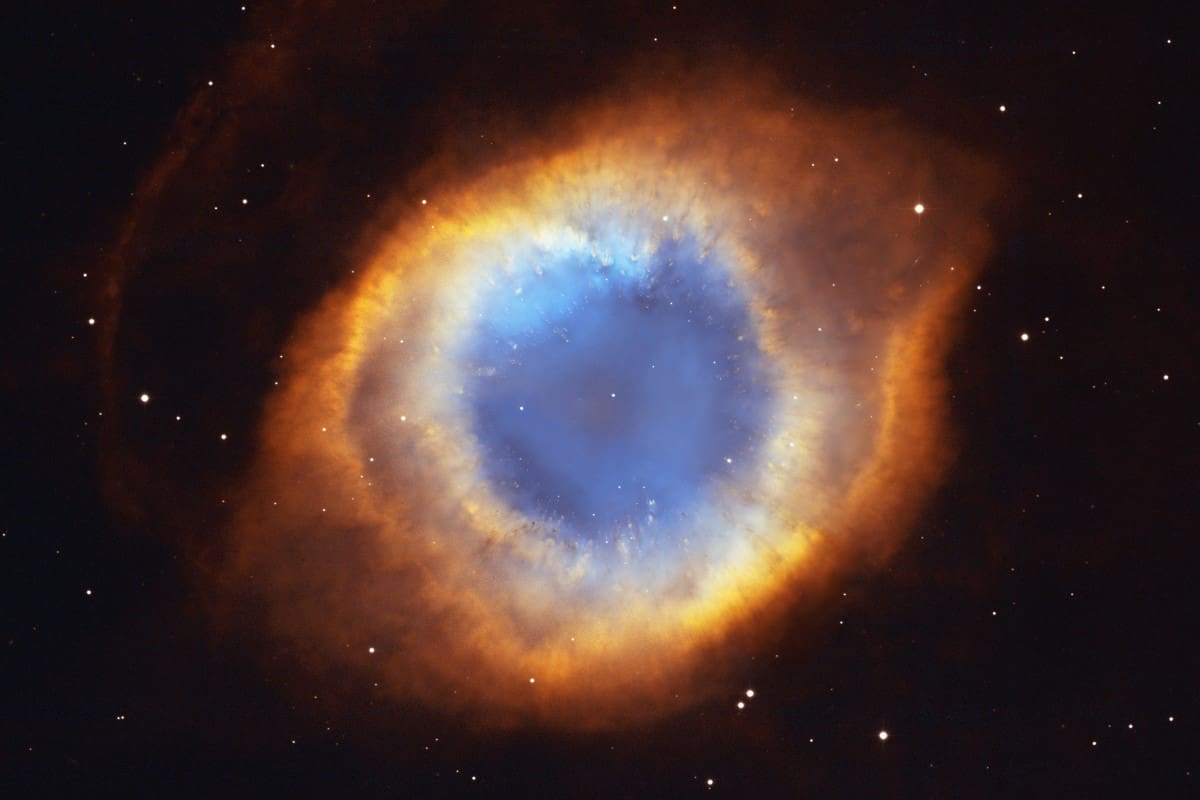
Planetary nebulae are some of the most enchanting and mesmerizing sights in the universe. These celestial objects, despite their name, have nothing to do with planets. Rather, they are colorful and intricate shells of gas and dust surrounding dying stars. Planetary nebulae form during the late stages of a star’s life, when it exhausts its nuclear fuel and undergoes a dramatic transformation.
In this article, we will explore 16 captivating facts about planetary nebulae that will leave you in awe of the vastness and beauty of our universe. From their stunning shapes to the mind-boggling processes that create them, planetary nebulae offer a glimpse into the cosmic drama unfolding billions of light-years away.
So, get ready to delve into the fascinating world of planetary nebulae as we unravel the mysteries behind these celestial wonders.
Key Takeaways:
- Planetary nebulae are the colorful remnants of dying stars, not related to planets. They play a crucial role in enriching galaxies and continue to fascinate scientists with their diverse shapes and compositions.
- Each planetary nebula is unique, displaying a wide range of shapes, colors, and structures. They provide clues about stellar evolution and may even contain complex organic molecules, sparking curiosity about their potential role in the universe.
Planetary nebulae are not actually related to planets.
Despite their name, planetary nebulae have nothing to do with planets. The term was coined by early astronomers who thought the nebulae resembled planets when viewed through a telescope.
Planetary nebulae are formed from dying stars.
Planetary nebulae are the remnants of dying stars, specifically low- to medium-mass stars like our Sun. As these stars reach the end of their lives, they shed their outer layers, creating the beautiful glowing clouds we observe as planetary nebulae.
There are thousands of planetary nebulae in our galaxy.
Scientists estimate that there are thousands of planetary nebulae in our Milky Way galaxy alone. However, due to their short lifespan of only a few tens of thousands of years, we can only observe a fraction of them at any given time.
Planetary nebulae display a wide range of shapes and colors.
Each planetary nebula has its own unique shape and color. Some appear circular or elliptical, while others have intricate and asymmetric structures. The colors observed in planetary nebulae are influenced by the types of atoms and molecules present in the gas clouds.
Planetary nebulae can be larger than our solar system.
Despite their name and compact appearance, planetary nebulae can span vast distances. Some planetary nebulae have been observed to have sizes larger than our entire solar system.
The central star in a planetary nebula is extremely hot.
At the heart of a planetary nebula is a hot, dense object known as a white dwarf. These white dwarfs can reach temperatures upwards of 100,000 degrees Celsius, emitting intense ultraviolet radiation that ionizes the surrounding gas and causes it to glow.
Planetary nebulae play a crucial role in the chemical enrichment of galaxies.
When a star enters its planetary nebula phase, it releases enriched material into space, including heavy elements that were synthesized in the star’s core. This material then becomes part of the interstellar medium, contributing to the formation of new stars and planetary systems.
Some planetary nebulae emit powerful jets of gas.
Not all planetary nebulae are calm and symmetrical. Some display powerful jets of gas shooting out from the central star, which can extend for thousands of astronomical units. These jets are thought to be a result of complex interactions between the central star and its surrounding environment.
The Butterfly Nebula is one of the most famous planetary nebulae.
The Butterfly Nebula, also known as NGC 6302, is a popular target for astronomers and space enthusiasts. Its wingspan-like structure and vibrant colors make it a captivating sight in the night sky.
Planetary nebulae fade away over time.
As planetary nebulae disperse into space, they gradually fade away and merge with the surrounding interstellar medium. Eventually, they become indistinguishable from the rest of the galaxy, leaving only their enriched stellar remnants, such as white dwarfs, behind.
The Ring Nebula was the first planetary nebula identified.
Discovered by French astronomer Antoine Darquier in 1779, the Ring Nebula (M57) in the constellation Lyra was the first planetary nebula to be recognized as such. Its distinctive ring-like shape has made it a popular subject for amateur astronomers.
Planetary nebulae can provide clues about stellar evolution.
Studying planetary nebulae can offer insights into the late stages of stellar evolution. By analyzing their structures and chemical compositions, astronomers can learn more about how stars like the Sun transform and eventually meet their demise.
Some planetary nebulae have been found to contain complex organic molecules.
While primarily composed of ionized gases, some planetary nebulae have been found to contain complex organic molecules, including hydrocarbons and amino acids. These discoveries hint at the potential for planetary nebulae to play a role in the formation of life-supporting environments in the universe.
The Cat’s Eye Nebula has intriguing concentric rings.
The Cat’s Eye Nebula (NGC 6543) showcases a series of concentric rings surrounding its central white dwarf. These rings are believed to be created by multiple ejections of material during different stages of the nebula’s formation.
Some planetary nebulae are double or multiple shells.
While many planetary nebulae possess a single shell-like structure, some display double or multiple shells. These complex formations may result from episodes of mass loss and ejection during the star’s evolution.
Planetary nebulae continue to be a topic of ongoing scientific research.
Even though scientists have made significant progress in understanding planetary nebulae, many mysteries still remain. Ongoing observations and studies aim to unravel the complexities of their formation, evolution, and role in the grand cosmic tapestry.
Conclusion
In conclusion, planetary nebulae are truly fascinating celestial objects that continue to captivate scientists and astronomy enthusiasts alike. Their mesmerizing colors, intricate structures, and transformation from dying stars to stunning cosmic remnants make them a subject of immense study and wonder.
With their importance in understanding stellar evolution and the processes that shape our universe, planetary nebulae have become vital in unlocking the secrets of the cosmos. As technology advances and our knowledge expands, we can look forward to discovering even more captivating facts about these cosmic wonders.
FAQs
1. What is a planetary nebula?
A planetary nebula is a type of astronomical object that forms when a star reaches the end of its life and expands into a red giant. The outer layers of the star are expelled, leaving behind a hot, dense core surrounded by a dazzling, glowing shell of gas and dust.
2. How are planetary nebulae formed?
Planetary nebulae are formed through the process of stellar evolution. As a star exhausts its nuclear fuel and swells into a red giant, the outer layers are expelled into space through stellar winds. These ejected materials then ionize and create the luminous shell characteristic of planetary nebulae.
3. What causes the vibrant colors in planetary nebulae?
The vibrant colors observed in planetary nebulae are due to the emission and absorption of specific wavelengths of light by different elements present in the nebulae. For example, oxygen emits green and blue light, while nitrogen and hydrogen can produce red hues.
4. How long do planetary nebulae last?
The lifespan of a planetary nebula is relatively short in astronomical terms, typically lasting only a few tens of thousands of years. After this time, the nebula disperses into space, and the remnant core, known as a white dwarf, becomes visible.
5. Can planetary nebulae support life?
Despite their beauty, planetary nebulae are not suitable environments for life. They consist mainly of gas and dust, with extremely high temperatures and low densities. Additionally, the intense radiation emitted by the central star would make it inhospitable for life as we know it.
6. Are planetary nebulae unique to our galaxy?
No, planetary nebulae are found in other galaxies as well. They are common cosmic phenomena, with billions of planetary nebulae estimated to exist across the universe. Observing planetary nebulae in other galaxies provides valuable insights into the processes that occur in stellar evolution.
7. Can planetary nebulae change in shape and size?
Yes, planetary nebulae can exhibit a wide variety of shapes and sizes. Factors such as the mass and rotation of the dying star, as well as the presence of a companion star, can influence the final structure of the nebula. Some planetary nebulae appear as symmetric spheres, while others take on more complex and asymmetric shapes.
Planetary nebulae offer a glimpse into stellar life cycles and galactic enrichment. Curious minds may also find interest in exploring the diverse nebula types that grace our cosmos. From emission nebulae's glowing gas clouds to reflection nebulae's ethereal light, each holds unique characteristics and scientific significance.
Was this page helpful?
Our commitment to delivering trustworthy and engaging content is at the heart of what we do. Each fact on our site is contributed by real users like you, bringing a wealth of diverse insights and information. To ensure the highest standards of accuracy and reliability, our dedicated editors meticulously review each submission. This process guarantees that the facts we share are not only fascinating but also credible. Trust in our commitment to quality and authenticity as you explore and learn with us.


